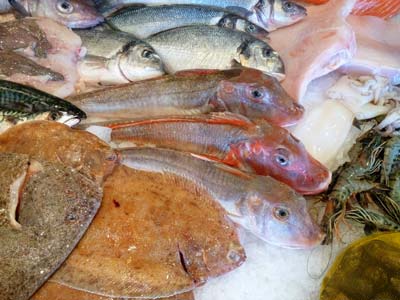Thrushes boned, stuffed with foie gras, truffle, juniper berries and a touch of cayenne pepper, wrapped in a pig's caul and cooked. The crumb is removed from a round loaf which is then stuffed with a forcemeat gratin. The thrushes are arranged inside this. The whole is served with the deglazed cooking juices from the thrushes, with a little additional butter and truffle.
Grey gurnard, the most common of the gurnards. Gurnards are strange-looking, bottom-feeding fish which use the three bottom rays of their pectoral fins to "feel" the sea bed. They have firm-textured white meat with not much flavour. They are rich in protein, iodine and phosphorus. The grey gurnard has a brownish-grey back and silver belly and all gurnards are very bony fish. Small ones are excellent in soup. Red or grey mullet (US: striped mullet) can generally be subsituted for it, and are usually better.

Gurnard. Gurnards are strange-looking, scaly, bottom-feeding fish with spikes which use the three bottom rays of their pectoral fins to "feel" the sea bed. They have firm-textured white meat with not much flavour, and are rich in protein, iodine and phosphorus. They emit a strange grunting noise and some make good eating. The grey gurnard (Eutrigla gurnardus) has a brownish-grey back and silver belly. The red gurnard (Aspitrigla cuculus) is the most attractive member of the family with pinkish-red colour and the finest flavour of the gurnards. The tub gurnard (Trigla lucerna) is a large brownish-orange variety with bright orange pectoral fins and is the one most readily available in the United Kingdom. There is a variety known as flying gurnard as it is a fine swimmer which sometimes leaps out of the water. They are all very bony fish. Small ones are excellent in soup. Red or grey mullet (US: striped mullet) can generally be subsituted for it, and are usually better.
Streaked gurnard. Gurnards are strange-looking, bottom-feeding fish which use the three bottom rays of their pectoral fins to "feel" the sea bed. They have firm-textured white meat with not much flavour. They are rich in protein, iodine and phosphorus. The grey gurnard (Eutrigla gurnardus) has a brownish-grey back and silver belly. The red gurnard (Aspitrigla cuculus) is the most attractive member of the family with pinkish-red colour and the finest flavour of the gurnards. The tub gurnard (Trigla lucerna) is a large brownish-orange variety with bright orange pectoral fins and is the one most readily available in the United Kingdom. There is a variety known as flying gurnard as it is a fine swimmer which sometimes leaps out of the water. They are all very bony fish. Small ones are excellent in soup. Red or grey mullet (US: striped mullet) can generally be substituted for it, and are usually better!

Tub gurnard. Gurnards are strange-looking, bottom-feeding fish which use the three bottom rays of their pectoral fins to "feel" the sea bed. They have firm-textured white meat with not much flavour. They are rich in protein, iodine and phosphorus. The tub gurnard is a large brownish-orange variety with bright orange pectoral fins and is the one most readily available in the United Kingdom. They are all very bony fish. Small ones are excellent in soup. Red or grey mullet (US: striped mullet) can generally be substituted for it, and are usually better.
Grey gurnard, the most common of the gurnards. Gurnards are strange-looking, bottom-feeding fish which use the three bottom rays of their pectoral fins to "feel" the sea bed. They have firm-textured white meat with not much flavour. They are rich in protein, iodine and phosphorus. The grey gurnard has a brownish-grey back and silver belly and all gurnards are very bony fish. Small ones are excellent in soup. Red or grey mullet (US: striped mullet) can generally be subsituted for it, and are usually better.